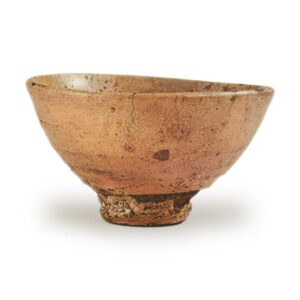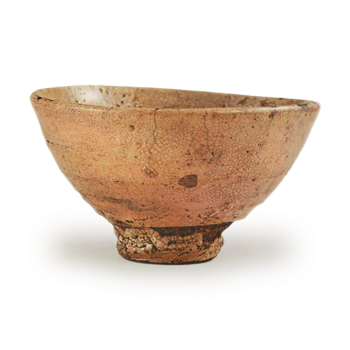
Well tea bowls are said to be the king of Korean tea bowls and have long been the most prized among tea masters. Not only are Ido tea bowls said to be the most famous, but they are also several times larger in quantity and variety than other tea bowls, probably because they were the most widely spread among the people in Joseon, and there were many kilns and many master craftsmen. The period when well tea bowls were fired is generally considered to be approximately six or seven hundred years ago. From the Dongshan period, Koryo tea bowls were prized along with Karamono tea containers, and after Juguang celadon, well tea bowls were the first to be recommended. Most of the Koryo tea bowls were made in the Yi Dynasty, but only one well tea bowl was considered to be an old Goryo Dynasty piece, and it attracted attention because of its age and the conditions for appreciation.
It is said that during the Tensho period (1573-92), one of these tea bowls was exchanged for 10,000 to 50,000 koku of rice, and even today some are valued at several million to several tens of millions of yen. There was once a suggestion that the Hondeido was produced in Hyeokjeon, Gyeongsangnam-do, and the Aoido in the eastern part of Yangsan-gun, Gyeongsangnam-do, but unfortunately, this could not be verified by excavating the site. The fact that there are so many types of wells suggests that the production area was large and that there were many kilns.
There are many types of wells, and there are not a few fine pieces other than tea bowls, and the old and the new of the period are also different, but the theory that the classification of types among tea masters is Meimonte (Oido), Ko-ido (Koido), Ao-ido, Ko-kaniri, and Idowaki, and that Ko-kaniri is the side (equivalent) of Ko-ido, and Idowaki is the side of Ao-ido, seems to be the most correct. The theory that Konukiiri is the side of an old well and Idowaki is the side of a blue well seems to be the most plausible. In other words, Konukiiri is inferior to Ko-Ido and Idowaki is inferior to Ao-Ido. However, some of the inferior wares have other characteristics that make them more interesting. See each section.
There are various theories about the origin of the name “Ido Chawan,” and although the most popular theory is that it is the name of a place in Korea, it is reasonable to assume that there is still no established theory. The following two or three theories are listed for reference. There is a theory that the name “Ido Tea Bowl” came from the fact that Ido Wakasamori Kakuhiro obtained it over there and brought it back to Japan during his expedition to Korea. According to the “Kansei Jyusho Shuju Shuju Shuyu”, “Ido Kakuhiro followed Tsutsui Sadatsugu to Nagoya in Hizen Province during the Joseon campaign, and then went to Korea under the command of Gifu Prime Minister Hidenobu, where he displayed military exploits and obtained ten saddle and Koryo ware tea bowls. Ieyasu returned one of the bowls to Kakuhiro and ordered him to make a well and gave it to him, as he had obtained it. In Arai Shiraishi’s Shinsho, it is written, “The bowl of Idote came from Joseon by Ido Sanjuro and was kept by Taikoh, and was always called Ido’s bowl. This is the most widely accepted theory as to the origin of the name “well,” but this theory must also be doubted if we look at a tea ceremony book from the Tensho period (1573-92) that refers to the bowl as “Toki Ji Ido Chawan. In other words, the name “well” is already found in records written before Ido Wakasamori, such as “Tsuda Munenori Nikki”, “Koori Chakai Ki”, and “Munetan Nikki”. In the “Yuroku”, it is written, “Some people say that the well tea bowl came from India, hence the name, but since India is a different name for Jersey, it is not true that it was written as a well in ancient times. It is said that the shape of the bowl resembles a well, and therefore the name “well” is a misnomer. In the “Ureshiyu Shoran”, it is written, “At this time, Taikoh took a tea bowl from Ido Wakasamori Joseon and presented it as Ido Teyaki, and since a well is something that is dug through, it is called Koudo Saikyo in Japanese, and the theory that Ido refers to the family name should not be true. Many people believe that Ido is the name of a place in Gyeongsangdo, referring to Weitong. Since Koraizaemon, the founder of Hagi ware, and Hachizo and Shinkuro, the founders of Takatori ware, are both said to have been from Weidoh, there must have been a pottery business there. Ido is probably a common rewriting of Weito. However, it is not clear where Weito is located. Some say that “Ido” may be a corruption of the Korean word for glaze, “clay,” but no definite theory has been developed yet.



